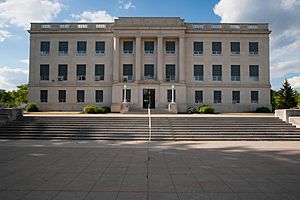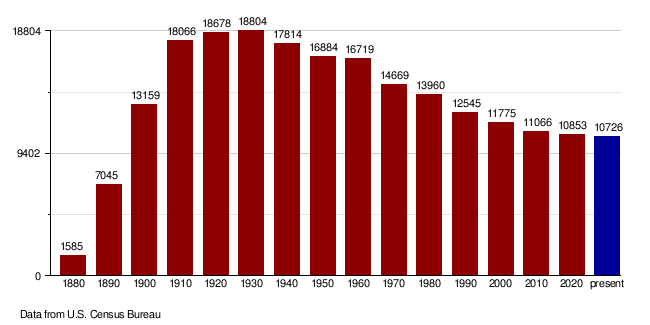Barnes County, North Dakota facts for kids
Quick facts for kids
Barnes County
|
|
|---|---|

Barnes County Courthouse
|
|

Location within the U.S. state of North Dakota
|
|
 North Dakota's location within the U.S. |
|
| Country | |
| State | |
| Founded | 1872 (created as Burbank) 1874 (renamed as Barnes) January 6, 1879 (organized) |
| Named for | judge Alanson H. Barnes |
| Seat | Valley City |
| Largest city | Valley City |
| Area | |
| • Total | 1,513 sq mi (3,920 km2) |
| • Land | 1,492 sq mi (3,860 km2) |
| • Water | 22 sq mi (60 km2) 1.4% |
| Population
(2020)
|
|
| • Total | 10,853 |
| • Estimate
(2023)
|
10,726 |
| • Density | 7.1732/sq mi (2.7696/km2) |
| Time zone | UTC−6 (Central) |
| • Summer (DST) | UTC−5 (CDT) |
| Congressional district | At-large |
Barnes County is a county in the U.S. state of North Dakota. As of the 2020 census, the population was 10,853. Its county seat is Valley City.
In 1872, the Dakota Territory legislature authorized Burbank County (named for governor John A. Burbank); in 1874 they renamed it Barnes County, for Alanson H. Barnes (1818–1890), an associate justice of the Territorial Court. It was organized at Valley City on January 6, 1879.
Contents
Geography
The Sheyenne River flows southerly through the central part of Barnes County. The county terrain consists of rolling hills, carved with drainages, and dotted with lakes and ponds. The area is largely devoted to agriculture. The terrain slopes to the south and east; its highest point is on its upper west boundary line, at 1,535 ft (468 m) ASL. The county has a total area of 1,513 square miles (3,920 km2), of which 1,492 square miles (3,860 km2) is land and 22 square miles (57 km2) (1.4%) is water.
Major highways
 I-94
I-94 US 52
US 52 ND 1
ND 1 ND 9
ND 9 ND 18
ND 18 ND 26
ND 26 ND 32
ND 32 ND 46
ND 46
Transit
- Jefferson Lines
Adjacent counties
- Griggs County – north
- Steele County – northeast
- Cass County – east
- Ransom County – southeast
- LaMoure County – southwest
- Stutsman County – west
Protected areas
- Clausen Springs Recreation Area
- Clausen Springs State Game Management Area
- Hobart Lake National Wildlife Refuge
- Koldak State Game Management Area
- Riparian Restoration Interpretative Site
- Stoney Slough National Wildlife Refuge
- Tomahawk Lake National Wildlife Refuge
Lakes
- Lake Ashtabula
- Eckelson Lake
- Fox Lake
- Goose Lake
- Hobart Lake
- Island Lake
- Kee Lake
- Lake Benson
- Meadow Lake
- Moon Lake
- Mud Lake
- Round Lake
- Saint Marys Lake
- Sanborn Lake
- Tomahawk Lake
Demographics
| Historical population | |||
|---|---|---|---|
| Census | Pop. | %± | |
| 1880 | 1,585 | — | |
| 1890 | 7,045 | 344.5% | |
| 1900 | 13,159 | 86.8% | |
| 1910 | 18,066 | 37.3% | |
| 1920 | 18,678 | 3.4% | |
| 1930 | 18,804 | 0.7% | |
| 1940 | 17,814 | −5.3% | |
| 1950 | 16,884 | −5.2% | |
| 1960 | 16,719 | −1.0% | |
| 1970 | 14,669 | −12.3% | |
| 1980 | 13,960 | −4.8% | |
| 1990 | 12,545 | −10.1% | |
| 2000 | 11,775 | −6.1% | |
| 2010 | 11,066 | −6.0% | |
| 2020 | 10,853 | −1.9% | |
| 2023 (est.) | 10,726 | −3.1% | |
| U.S. Decennial Census 1790-1960 1900-1990 1990-2000 2010-2020 |
|||
2020 census
As of the 2020 census, there were 10,853 people, 4,772 households, and 2,751 families in the county. The population density was 7.3 inhabitants per square mile (2.8/km2) There were 5,671 housing units.
2010 census
As of the 2010 census, there were 11,066 people, 4,826 households, and 2,927 families residing in the county. The population density was 7.4 inhabitants per square mile (2.9/km2). There were 5,704 housing units at an average density of 3.8 units per square mile (1.5/km2). The racial makeup of the county was 96.4% white, 0.8% black or African American, 0.7% American Indian, 0.5% Asian, 0.2% from other races, and 1.4% from two or more races. Those of Hispanic or Latino origin made up 1.1% of the population. In terms of ancestry, 48.4% were German, 37.2% were Norwegian, 8.3% were Irish, 5.2% were English, and 2.7% were American.
Of the 4,826 households, 24.8% had children under the age of 18 living with them, 50.8% were married couples living together, 6.4% had a female householder with no husband present, 39.3% were non-families, and 32.9% of all households were made up of individuals. The average household size was 2.19 and the average family size was 2.79. The median age was 44.3 years.
The median income for a household in the county was $41,773 and the median income for a family was $59,558. Males had a median income of $42,575 versus $30,361 for females. The per capita income for the county was $26,152. About 6.4% of families and 12.0% of the population were below the poverty line, including 12.6% of those under age 18 and 14.6% of those age 65 or over.
Population by decade

Communities
Cities
- Dazey
- Fingal
- Kathryn
- Leal
- Litchville
- Nome
- Oriska
- Pillsbury
- Rogers
- Sanborn
- Sibley
- Tower City (part)
- Valley City (county seat)
- Wimbledon
Unincorporated communities
Townships
- Alta
- Anderson
- Ashtabula
- Baldwin
- Binghampton
- Brimer
- Cuba
- Dazey
- Eckelson
- Edna
- Ellsbury
- Getchell
- Grand Prairie
- Green
- Greenland
- Hemen
- Hobart
- Lake Town
- Mansfield
- Marsh
- Meadow Lake
- Minnie Lake
- Nelson
- Noltimier
- Norma
- Oakhill
- Oriska
- Pierce
- Potter
- Raritan
- Rogers
- Rosebud
- Sibley Trail
- Skandia
- Spring Creek
- Springvale
- Stewart
- Svea
- Thordenskjold
- Uxbridge
- Valley
- Weimer
Notable people
- Frank White, eighth Governor of North Dakota and Treasurer of the United States.
- Peggy Lee, singer & actress
- Earl Pomeroy, U.S. Congressman
- Morley Nelson, conservationist
Education
School districts:
- Barnes County North Public School District 7
- Enderlin Area Public School District 24
- Griggs County Central School District 18
- Hope-Page School District
- Litchville-Marion Public School District 46
- Maple Valley Public School District 4
- Montpelier Public School District 14
- Valley City Public School District 2
Former districts:
- Hope Public School District 10 - Consolidated with Page district in 2020
- Oriska School District - Consolidated into Maple Valley in 2003
- Page Public School District 80 - Consolidated with Hope district in 2020
See also
 In Spanish: Condado de Barnes para niños
In Spanish: Condado de Barnes para niños

